Digital Poster
IVIM
ISMRM & ISMRT Annual Meeting & Exhibition • 10-15 May 2025 • Honolulu, Hawai'i

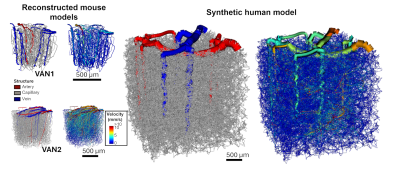 |
Computer Number: 65
2022. Revisiting
random cylinder models in IVIM: biophysical simulations of
realistic microvascular networks reveal asymmetries and
heterogeneity
G. Hartung, Z. Hu, V. Phi Van, D. Varadarajan, M. Cloos, J.
Polimeni
Technical University of Darmstadt, Darmstadt, Germany
Impact: Microvascular architecture and dynamics are not
random and both influence the IVIM signal, yet
interpretation currently relies on simplified vascular
models using random cylinders. We characterized IVIM
parameters in realistic microvasculature of the brain,
revealing biases absent in simpler models.
|
|
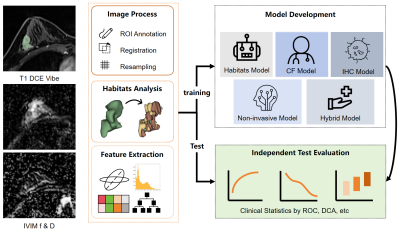 |
Computer Number: 66
2023. Breast
cancer: Intravoxel incoherent movement-based habitat imaging for
predicting pathologic complete response to neoadjuvant
chemotherapy
M. He, M. Sun, X. Liang
Shengli Clinical College of Fujian Medical University & Department of Radiology, Fujian provincial hospital, Fuzhou University Affiliated Provincial Hospital, Fuzhou 350001, China, China
Impact: The habitat model combined with conventional MRI
features and IHC findings accurately predicted pCR before
NAC.
|
|
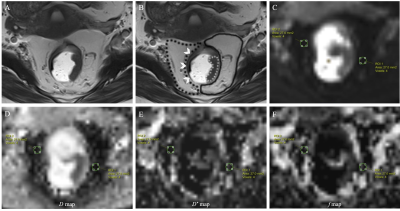 |
Computer Number: 67
2024. Assessment
of Mesorectal Microstructure and Microcirculation with
Intravoxel Incoherent Motion MRI
X. Yang, L. Huang, S. Yu, Z. Wen
Zhujiang Hospital, Southern Medical University, Guangzhou, China
Impact: The mesorectum that surrounded the rectal tumor
had a more complex microstructure and a higher microvascular
prefusion than that close to the normal rectal wall. The
mesorectal microenvironment might be an interesting point
for further MRI study in rectal cancer.
|
|
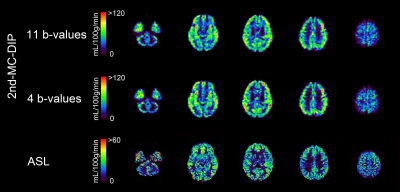 |
Computer Number: 68
2025. Accelerated
second-order motion-compensated diffusion imaging with
phase-contrast for regional cerebral blood flow quantification
N. Ohno, T. Miyati, S. Nakatani, N. Alperin, Y. Ueda, S.
Kobayashi
Kanazawa University, Kanazawa, Japan
Impact:
Optimized b-value selection achieved a three-fold reduction in acquisition time, making 2nd-MC-DIP practical for clinical use in accurate rCBF quantification. |
|
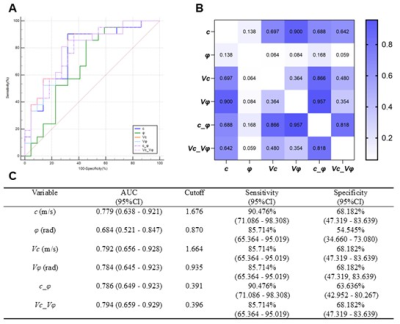 |
Computer Number: 69
2026. IVIM-based
virtual MR elastography for predicting fibrosis severity in
rectal cancer: A comparison with conventional MR elastography
Y. Luo, M. Li, W. Liu, H. Zhang, Y. Pei, W. Li
Department of Radiology, Xiangya Hospital of Central South University, Changsha, China
Impact: v-MRE is a reliable alternative to MRE in
diagnosing the degree of fibrosis in RC, which may assist
clinicians in developing neoadjuvant therapeutic strategies
for RC.
|
|
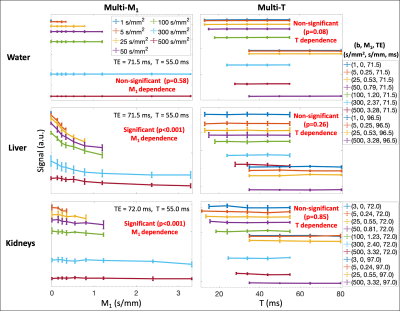 |
Computer Number: 70
2027. Dependency
of the IVIM Signal on the First-Order Motion Moment and Encoding
Duration in the Liver and Kidneys
G. Simchick, D. Hernando
University of Wisconsin-Madison, Madison, United States
Impact: In the liver and kidneys, a combined ballistic
and pseudo-diffusion IVIM signal model with b and M1 dependence
may be valid. IVIM models that depend on T may
be inaccurate in these organs for T approximately
11.5-80.5ms.
|
|
 |
Computer Number: 71
2028. Validation
of IVIM Perfusion and Diffusion Mapping to Detect Bone Marrow
Ischemia: A Piglet Model Study
E. Buko, A. Amann, F. Tóth, C. Johnson
University of Minnesota, Saint Paul, United States
Impact: IVIM imaging can detect bone marrow perfusion,
ischemia, and injury, which is potentially clinically useful
to evaluate ischemic bone disorders, including
Legg-Calve-Perthes disease and other pediatric disorders for
which there is a need for safer alternatives to gadolinium
contrast-enhanced MRI.
|
|
 |
Computer Number: 72
2029. Characterization
of human brain IVIM signal using two-dimensional T2-diffusivity
spectrum analysis based on multi-echo diffusion MRI
Z. Hu, D. Varadarajan, Y. Jun, G. Hartung, A. Arsenovic, L.
Lewis, S. Huang, K. Kwong, B. Bilgic, B. Rosen, J. Polimeni
Massachusetts General Hospital, Charlestown, United States
Impact: We demonstrated that CSF contamination in human
brain IVIM signals can be effectively removed with a
two-dimensional T2-diffusivity spectrum analysis based on
multi-echo diffusion MRI. Whether the extracted blood
compartment can reveal microvascular flow information will
require further studies.
|
|
 |
Computer Number: 73
2030. Nomogram
based on neutrophil-to-lymphocyte ratio and MR diffusion
parameters for predicting Ki67 in hepatocellular carcinoma
Y-c Wei, Y. Liang, Y. Liang, H. Qin, J-y Liao
Department of Radiology, The First Affiliated Hospital of Guangxi Medical University, NanNing, China
Impact: This study presents a noninvasive model for
predicting Ki67 in hepatocellular carcinoma, combining NLR,
imaging features, and MRI diffusion parameters to improve
preoperative risk stratification. It may reduce biopsy
needs, support personalized treatment planning, and aid in
monitoring treatment response.
|
|
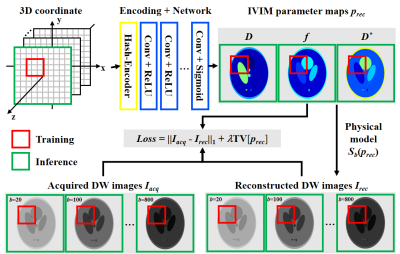 |
Computer Number: 74
2031. PIC-INR:
Scan-specific unsupervised IVIM parameter mapping using
physics-informed convolutional implicit neural representation
J. Wang, L. Wang, C. Cai, S. Cai
Jimei University, Xiamen, China
Impact:
Our scan-specific unsupervised method, employing physics-informed convolutional implicit neural representation, has successfully achieved accurate IVIM parameter mapping without relying on reference maps and external data during network training. |
|
 |
Computer Number: 75
2032. IVIM-MRI-Derived
Robustness Index for Evaluating ADT Response and Hypoxia in
Prostate Cancer
Y-P Liao, Y. Dai, N. Desai, X. Jia, J. Deng
UT Southwestern Medical Center, Dallas, United States
Impact: This optimized IVIM parameter Ri can be used for
detection of ADT response and assessment of tumor hypoxic
environment in prostate cancer prior to radiation therapy,
providing a valuable tool for evaluating treatment effects
on the tumor microenvironment.
|
|
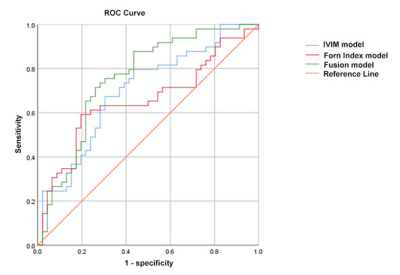 |
Computer Number: 76
2033. Identification
of early and advanced hepatic fibrosis stages in patients with
chronic hepatitis B using IVIM parameters and Forns index
T. Liu, L. Huang, W. Liu, J. Chen, W. Zhang, J. Tang
Guangdong Provincial Hospital of Traditional Chinese Medicine, Zhuhai, Zhuhai, China
Impact: Indeed, Early diagnosis of liver fiber by
non-invasive method can bring benefits to the clinical
treatment of patients with chronic liver disease. IVIM
combined with Forn index is a relatively excellent
indicator, which can reflect the grade of liver fibrosis.
|
|
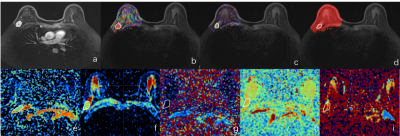 |
Computer Number: 77
2034. Diagnostic
Value of Combined IVIM, DKI, and DCE-MRI in Differentiating
Benign and Malignant Breast Lesions
Y. Wang, J. Li, N. Zhou, Y. Zhou, F. Fu, C. Gao, M. Chen
The First Affiliated Hospital of Kunming Medical University, Kunming, China
Impact: The integration of IVIM, DKI, and DCE-MRI
enhances diagnostic precision in breast lesion
differentiation, potentially improving clinical
decision-making and patient management by providing a more
accurate non-invasive assessment, which could guide tailored
treatment strategies for breast cancer patients.
|
|
 |
Computer Number: 78
2035. Extended
intra-voxel incoherent motion (X-IVIM) modeling in breast cancer
patients for improved quantitative cancer markers
M. Medved, Z. Ren, H. Whitney, G. Karczmar
The University of Chicago, Chicago, United States
Impact: Successful implementation of extended
intra-voxel incoherent motion (X-IVIM) modeling in breast
MRI will facilitate development of non-contrast enhanced MRI
protocols for breast cancer screening. This will reduce
barriers of risk, inconvenience, and cost and increase
compliance with screening recommendations.
|
|
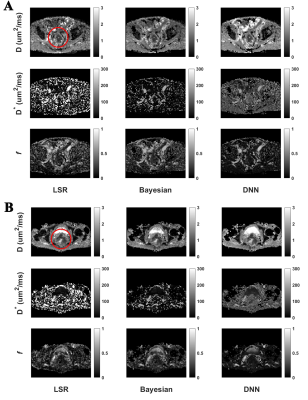 |
Computer Number: 79
2036. Deep
Neural Network for Enhanced Intravoxel Incoherent Motion Fitting
in Rectal Cancer
X. Li, B. Lu, J. Yin, X. Xin
South China University of Technology, Guangzhou, China
Impact: The DNN demonstrated superior performance
compared to LSR and Bayesian algorithms, significantly
enhancing the precision and reproducibility of the IVIM
fitting, thereby potentially improving the clinical
applicability of IVIM model in rectal cancer.
|
|
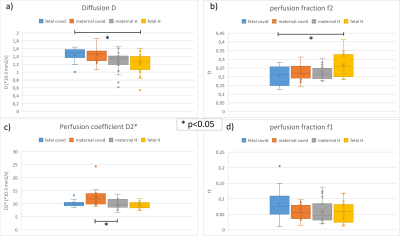 |
Computer Number: 80
2037. Microstructural
and physiological changes in SARS-CoV-2 pregnancy infection by
two perfusion IVIM model
A. Maiuro, C. Cutonilli, G. Rizzo, M. G. Porpora, C.
Catalano, A. Giancotti, L. Manganaro, S. Capuani
Sapienza University of Rome, Rome, Italy
Impact: Two-perfusion-IVIM model has highlighted a
trophoblast perfusion impairment in SARS-CoV-2 placentas not
visible by the f parameter of IVIM. Two-perfusion-IVIM opens
the possibility of in-depth investigations of different
viruses’ infections on placental tissues.
|
The International Society for Magnetic Resonance in Medicine is accredited by the Accreditation Council for Continuing Medical Education to provide continuing medical education for physicians.